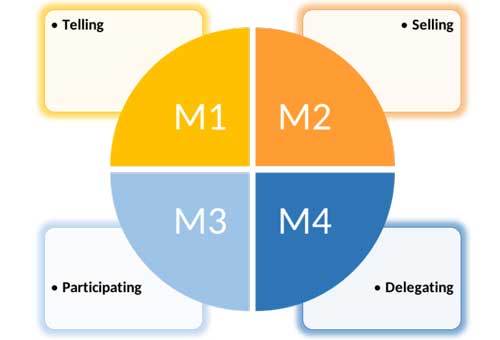Situational leadership is about adapting the style of leadership to employees involved, with an eye to the environment within which they operate. It is therefore more about a leader’s ability to adjust to the situation in front of her, than about personal leadership skills.
Situational leadership, in short, takes people in context seriously. The leader applies the leadership style that is best suited to the situation. The leader is agile.
Situational leadership is related to contingency theory therein they both view success as a result of matching leadership abilities and style with the situation. Yet, where contingency theory focuses on matching leadership style with the situation as such, situational leadership theory places a specific focus on matching leadership style with follower requirements.
This implies also that there is no ‘one-size-fits-all’. You may say that situational leadership is flexible as it adapts to the needs of the followers in context.
During times of transition, situational leadership is key in keeping an organization afloat – swiftly implementing organizational change to match new markets and so forth – can be the difference between prosperity and bankruptcy.
The literature offers us mainly two theories of Situational Leadership
- Situational Leadership according to Blanchard and Hersey
- Situational Leadership according to Daniel Goleman
Let’s start out by looking at Blanchard and Hersey’s model.
The Situational Leadership Model by Blanchard & Hersey
Blanchard and Hersey connect four different styles of leadership with four different stages of employees’ development – here called Maturity Levels.
The situational leader will make an optimal match between leadership style and maturity level.
The four leadership styles, introduced by Blanchard & Hersey, are:
1. Telling (matching Maturity Level 1, see below). Use a telling leadership style when the team needs close supervision and guidance. Make decisions, create roles, objectives, and convey these to employees, who you expect to act accordingly. Works best during a crisis or when in need of repetitive results.
2. Selling (matching level 2). Use a selling leadership style when the commitment among employees is low. Explain and sell ideas and strategies to engage and motivate all involved. Communication is not entirely one-way as with the Telling leadership style; the leader is open to hearing the ideas of the employees.
3. Participating (matching level 3). Use a participating leadership style when the team has a high level of competency and mainly needs a leader to facilitate the process. You may share your expertise, yet employees will likely make the final decisions.
4. Delegating (matching level 4). Use a delegating leadership style when you have confidence that the team has both the skill and motivation to problem solve on their own. You may stand by for questions, while your involvement is minimal.
No leadership style is to be viewed as better than the other. It is about matching leadership style with employees’ Maturity Levels – to ensure success.
To the question: Which leadership style is best? The answer is: that depends!
Let’s look at the four Maturity Levels
Maturity Levels
Maturity Levels are also called Readiness levels or Stages of Employee Development:
Level M1: Low Competence: High Commitment
Level M2: Variable Competence: Low Commitment
Level M3: High Competence: Variable Commitment
Level M4: High Competence: High Commitment
To maximize success, the leader is to lead according to the style that matches employees’ Maturity Level best. Leadership style 1 (Telling) is suggested to best match Maturity Level 1. Leadership style 2 matches Maturity Level, 2, and so forth. Note that these will vary across team members and again: no one-size-fits-all! By LumenLearning
Let’s move on to have a look at Daniel Goleman’s situational leadership theory.

The Situational Leadership Theory by Daniel Goleman
Daniel Goleman – the author of Emotional Intelligence – incorporates the concept of emotional intelligence into the theory of situational leadership.
Goleman creates six categories of situational leadership styles, where he, for each leadership style, makes a suggestion for when it is best applied.
Let’s look at the six categories.
Goleman’s Six Leadership Styles
1. The coercive style – ‘Do what I say’ approach
- Effective in acute situations and for quick and effective turnarounds of situations. It is however inflexible and may reduce employee motivation. The coercive style proves to be the least effective in most situations.
2. The authoritative (visionary) style – ‘Come with me’ approach
- The goal is called out, yet employees are largely free to pursue it the way they see as best fit. May work well for an organization that needs firm steering to get back-on-track, yet works less well with experts holding expertise beyond the level of the leader.
3. The affiliative style – People come first’ attitude
- Highly useful for building team harmony and increasing morale. However, an exclusive emphasis on praise may leave errors uncorrected and employees in need of direction and advice.
4. The democratic style – ”What do you think?’ approach
- Workers are included in decision making and thereby the leader builds organizational flexibility and responsibility. While the democratic leader takes into account employees’ ideas and input, it may well result in too many meetings where employees to a large extent feel like being without a leader.
5. The pacesetting style – ‘Do as I do now’ approach
- Workers who like a high pace will like pacesetting leaders, who set high-performance standards exemplified by their own practice. Others may be overwhelmed by the pace and ambition and so dislike this tendency to take control of situations.
6. The coaching style – ‘Try this’ attitude
- Personal development more than task completion is central to the coaching leader. It works well to collaborate with an employee about surpassing a recognized weakness. It reaches, however, a stalemate when the employee’s readiness for change is low.
Goleman emphasizes that the ability to master the individual leadership styles – and perhaps more importantly, the ability to shift among styles as conditions dictate – is the way to create a healthy organizational climate and optimize business performance (2000).
Drivers of Climate Change
Six factors influence an organizations’ working environment. Here they are in Goleman’s own words (2000):
- Flexibility – how free employees feel to innovate -unencumbered by red tape
- The sense of Responsibility – to the organization
- The level of standards that people set
- The sense of accuracy about performance feedback and aptness of awards
- The clarity people have about mission and values
- The level of commitment to a common purpose.
Research shows that leaders’ emotional intelligence does affect leadership style and the style affects in turn the respective employees’ feelings regarding organizational climate to various degrees (Maamari & Majdalani 2017: 1).
Organizational drivers can be viewed as management techniques that facilitate an understanding of the way workers view their working environment (Maamari & Majdalani 2017: 5).
Situational Leadership Examples
Example 1: Situational Leadership During Times of Quick Change
Let’s imagine a production company facing potential lock-down within the week – due to COVID-19.
In this situation, where a deadline has to be met within a week, a telling or coercive leadership style is appropriate. The reason is that there is no time to discuss a palette of possibilities for change. A democratic leadership style in this instance would be at dire risk of not meeting the one-week deadline.
Once the lock-down is a reality and all employees are working from home, then a selling leadership style is appropriate for those employees, who feel somewhat demotivated by the lock-down. On the other hand, those who are eager to keep a high pace and moreover have the competencies to do their work, need no telling or selling. Then a participating or delegating style fits better the maturity level of employees.
It’s important to embrace how a changing situation within days and sometimes even hours, may call for different leadership styles.
Example 2: Planning a Music Festival
In the initial phases, you want to hear and collect employees’ great ideas by using a participating and delegating leadership style. This is also what Goleman refers to as a democratic approach where all people are heard and involved in the decision making process.
As the day of the event comes closer, there is perhaps a need for speeding up processes and this dictates a pacesetting leadership style. The last days up to the event there is little room for new ideas as it will take to long to implement them. Instead, all involved must focus on getting things done as planned. Now it’s time perhaps to implement a vibrant and visionary authoritative (telling) leadership style that will ensure that all things are in place when the festival is set to begin.
Again – it all depends on the people and the situation you are working with. The message from Goleman is to expand your repertory to include all six leadership styles. To do that you must understand the underlying emotional intelligence competencies of the leadership styles you lack (Goleman 2000: 14).
If you are interested in learning in more detail about Daniel Goleman’s concepts of Emotional Intelligence, please go to the following article where the four pillars of Emotional Intelligence are explained:
Project Leadership: Moving from Project Management to Project Leadership (3/3)
References
Goleman, Daniel (2000). Leadership that Gets Results. In Harvard Business Review, March 2000.
Maamari, Bassem, and Joelle F. Majdalani (2017). Emotional intelligence, leadership style & organizational climate. International Journal of Organizational Analysis, 25(2).









